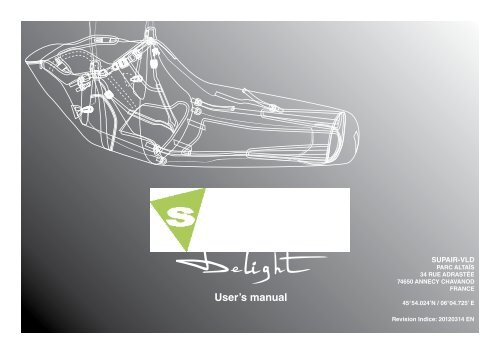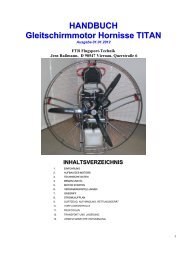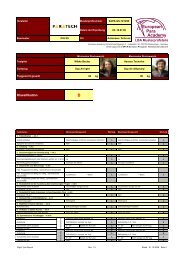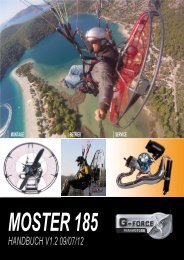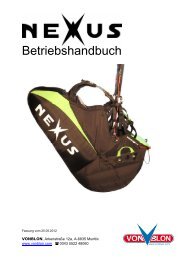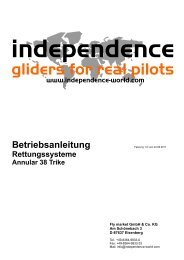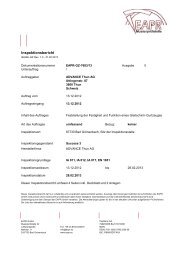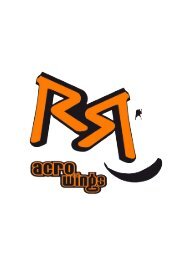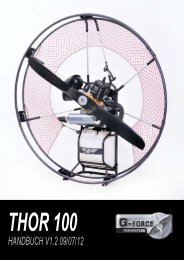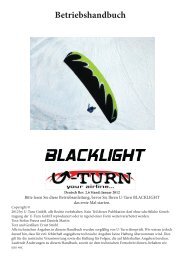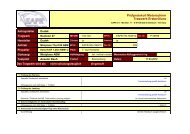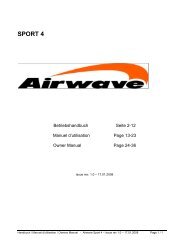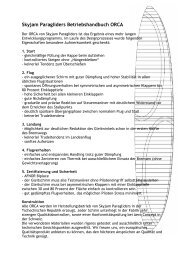You also want an ePaper? Increase the reach of your titles
YUMPU automatically turns print PDFs into web optimized ePapers that Google loves.
User’s <strong>manual</strong>SUPAIR-VLDPARC ALTAÏS34 RUE ADRASTÉE74650 ANNECY CHAVANODFRANCE45°54.024’N / 06°04.725’ ERevision Indice: 20120314 EN
List of contentsList of contents 3Introduction4Technical sheet 5Technical specifications 5Size choice 6Nomenclature7Harness overview 8Storage and attachments 9Rescue parachute pocket characteristics 10Connecting the handle to the rescue parachute’s deployment bag10Rescue parachute assembly 10Placing the parachute in the rescue parachute pocket 11Connecting the rescue parachute risers to the harness : Y risers 12Connecting the rescue parachute risers to the harness : standardrisers13Cockpit and BUMPAIR assembly 14Speedbar assembly 15Position setting 16Speedbag angle setting 17Leaning angle setting 17Shoulders’ straps adjustment 17All the pictures of this user’s<strong>manual</strong> were shot by ThomasDe Dorlodot and Horacio LLorensduring their 2011 expeditionin Pakistan where theyset many new records suchas Himalayan distance record(225 km).More information on :www.xp.supair.comFlight behaviour 18Pre-Flight control 19Take-off20In flight 21Speedbar use 21Landing22Throwing the reserve parachute 22Complements/Accessories23Wash and care of your harness 24Storage and transport 24Lifetime24Care24Repair25Materials25Recycling25Warranty26Disclaimer26Pilot’s gear 26Warranty26Service Book 273
IntroductionWelcome to the world of lightweight performance! You have in your hands the key that opens thedoor to exceptional flights. The DELIGHT is our most persuasive invitation to adventure and withit you will be able to go higher, further and fly longer. Now, you just have to find a playground bigenough !After reading this <strong>manual</strong>, we suggest you check your harness by hanging in it before flying.N.B : Three important icons will help you when reading this <strong>manual</strong>Advice Caution ! Danger !4
Technical sheetACBCDDABBack heightLeaning settingheightHauteur du dosSeat lengthHauteur réglage del'inclinaison dudossierSeat widthLongueur d'assiseLargeur d'assiseEFGEFHauteur des pointsGDistance entre lespointsLongueur speedbagCarabiners heightCarabinersdistanceSpeedbag lengthFEModel DELIGHT M DELIGHT LPilot size 1 m 55 -1 m 90 1 m 70 -2 m 05Weight 60 - 80 kg 75 - 100 kgHarness weight (+ carabiners+speedbar)Designed for (cm)2,3 kg2,55 kg(+ 140g+ 25g) (+140 g + 25 g)Paragliding onlyBack height (cm) 57 61Leaning setting height (cm) 29 32Seat length (cm) 50 50Seat width (cm) 33-37 33-37Carabiners height (cm) 44 44Carabiners distance (cm) 28-45 28-45Speedbag length (cm) 100-120 105-125Impact damping system : Airbag (Volume)NoImpact damping system : Bump’air (Thickness)HomologationFlight : tandem (Pilot- Passenger)Flight : acrobatic flyingWinching :Technical specificationsYes - 14 cmEN 1651 - LTFNo-NoNoNoABDCG5
Nomenclature12SpeedbarRescue parachutehandle67Zicral 30 mm carabiners(x2)Bumpair 14 cm13Rescue parachute risers8FootrestUnique size4O rings (x2)9Cockpit5Maillon Rapide ®Inox 7 mm (x1)23 4567897
Harness overviewThis illustration will help you during your reading.1 Boucle ventrale droite1 Right ventral buckle8767512342 Boucle Left ventrale automatic ventral buckle2 automatique gauche3 Safe Safe-T-bar T Bar3(Sup’Air patent A1-1832/981)4 Boucle de cuissarde4 Thigh strap buckle1641010101091155Réglage Ventral écartement width adjustment deventrale66Réglage Leaning de l'inclinaison settingdu dossier7 Réglage Shoulders’straps des épaulettes adjustment78 Back pocket8 Poche dorsale99PlanFeetdeglideglissementpart1210Speedbag leaning adjustment10 Réglage de l'inclinaison du11 cocon Footrest11 Planche de pieds12 13 Speedbag closing buckles121413 Rescue Boucles de parachute fermeture handle speedbag15141315 Rescue parachute pocket14 Poignée du parachute de secours16 Harken® Pulley15poche parachute de secours16Poulies Harken8
Storage and attachments41354231Cockpit1 Cockpit32Lateral storage pocket2 Poche latéralede rangement2334Walking poles holder handgriptopBack pocket3 Porte-bâtonsPoignées vers le haut4 Poche dorsalede rangement5 Poche sous-cutalepour ballast (≈ 3l)5Under seating pocket forballast (3 litres)9
Rescue parachute assemblyRescue parachute pocket characteristics• 4 flaps back pocket.• Cable locking.• Handle on the right-hand side.• Volume : 3 to 6,5 litres.• Compatible with the SUPAIR lite and XTRALITEand other solo parachutes.Connecting the handle to the rescue parachute’s deployment bagThanks for reading carefully ! We recommend the initial rescueparachute assembly and installation is made by a qualified person.ABCDDELIGHT rescue parachutehandleParachute folded accordingto manufacturersspecification and in deploymentbag.Parachute rigging linesParachute risers (Y-risersor standard risers)AY-Risers : make a lark’s headand connect the risers to theharness using Maillon Rapide® Inox 6 or 7 mm (x2)see page 12BCA :Standard Risers : use oneMaillon Rapide ® Inox 7 mm.See page 13DB :1. Place the handle insidethe middle webbing loop andmake a lark’s head knot withthe handle.2. Fasten tightly the lark’shead knot and verify the solidityof the link.10
ACBDOeilletsvolet supérieurOeilletsvolet inférieurPlacing the parachute in the rescue parachute pocket1. Placer les sangles des2. Placer le parachute3. Prendre uneélévateurs et les suspentes dupar dessus.drisse et la passerparachute correctement Thanks for reading carefully ! We recommend dans la cordelette the initial rescuelovées.parachute assembly and installation is made côté by poignée a qualified person.4. Tireet la fdansABUppergrommetsflapABCDUndergrommetsflapDC1. Place the risers’ straps andthe rigging lines of the parachuteclearly coiled2. Place the parachutein its pod on top of therisers and lines.3. Take a suitable line andpass it inside the snapperon handle’s side.4. Pull the snapper andpass it through the Bgrommet.When the assembly iscomplete, perform a testpull of the handle to ensurethe compatibilityand the correct deploymentof the rescue (pod+ handle). Then reassembleas previouslydone.5. Pass the snapperthrough the C grommetand pass the handle’s5. Passer la cordeletteinside dans l'oeillet the hole C ofcablethe puis down passer flap le and jonc finallyinside la poignée the snapper. dans Pullaway le trou gently du volet the lineinférieur puis dansla cordelette.Retirer doucement6. Place the line throughthe other snapper in theA and D grommets (up6. Placer la drisseand dans down l'autre cordelettepuis #5. placer laflaps). Repeatstepcordelette dans lesoeillets A et D(volets inférieur etsupérieur). Répéterl'étape 6.7. Put the cable triminside the flap pocket8. Glisser l'extrémitélibre du jonc dans lapoche du volet8. Turn down the lastflap 8 and Rabattre place le dernier the handlevolet on its et velcro. placer lapoignée sur sonvelcro.11
Connecting the rescue parachute risers to the harness : Y risers1. Place the Maillon Rapide®Elévateur parachute de(locking nut upwards and onsecoursexterior side) inside the webbingloop. Place the O-ringinside the Maillon and twist it.2. Pass the riser insidethe free loop and insidethe Maillon Rapide®.3. Make a new twistedloop with the ring andpass it inside the MaillonRapide®.4. Repeat steps #1, #2 and#3 with another O-ring for theconnexion to harness. Tightenthe Maillon Rapide® lockingnut correctly, with a spanner ifneeded.2311Maillon Rapide ® Inox6 mmn (x2)5. Neatly stow any surplus risersunder the flaps.2O-Rings (x2)3Parachute risers12
Connecting the rescue parachute risers to the harness : standard risersYour DELIGHT is fitted with light standard parachute risers1. Make a lark’s headbetween the risers andthe webbing loop forrescue attachment.2. Fasten the lark’s headneatly121Rescue parachutestandard risers3. Neatly stow any surplus risersunder the flaps.2Webbing loop for rescuerisers attachment13
Cockpit and BUMPAIR assemblyA- Connect the female buckle (1) to themale buckle (2).B- Connect the cockpit’s velcro patches(4) to the speedbag’s velcro patches (5).C - Pass the male buckle on speedbag(7) through the the strap loop with snapfasteners (6) and connect it to the femalebuckle (3) of the harness.123Female buckleHarnessMale buckleCockpitFemale buckle onbraided ropeHarness13A124B545VelcroCockpitfastening-Velcro fastening onspeedbagHarnessC7636789Strap with snap fastenersCockpitMale buckle onspeedbag- HarnessBumpair 14 cmInternal cell with velcrofor bumpairDE8D- Unzip the pocket and unfasten the internal cellwith velcro (9). Push the BUMPAIR (8) inside thepocket under the seat.89E- Fasten the internal cell with velcro (9) and zipthe pocket.14
Speedbar assemblyA light speedbar is provided with harness. The following illustration shows how to install it.CompositionEABBraided ropesFirst barABCCentering spacerADCDESecond barSpeedbar hook1Pass the speedbar braided rope insidethe plastic keeper.132Pass the speedbar braided ropeoutside the strap.23Pass the speedbar braided rope insidethe pulley.4Pull out the braided rope outsidethe speedbag.4 55Pass the braided rope inside thespeed bar hook then tighten thehooks to the risers’ acceleratorloops. Adjust the length beforemaking a bowline knot.15
Position settingSetting your position inside the harness before taking-off is extremely important.B1Lateral buckles21 Boucles latéralesUnder seating buckle34Tightening snapper 2(leaning setting)3Loosening strap(leaning setting)Boucle sous-cutalesCordelette de serrage6374A567Sangle de désserrage4 (réglage inclinaisonLumbar adjustmentdossier)buckle5Tightening snapper(shoulder strap) 6Loosening strap 7( shoulder strap)Boucle de d'ajustement desoutien lombaireCordelette de serrage(sangle d'épaule)Sangle de désserrage(sangle d'épaule)5B431122C76516
ASpeedbag angle settingWith the help of the two lateral and under seating buckles, set theangle of the speedbag around horizontal position.BLeaning angle settingBSet the angle of leaning by tightening the snapper (towards a morevertical position) or the black webbing (towards a more horizontalposition).tightenYou can extend the lumbar support by tightening the #5 buckle.loosenCCShoulders’ straps adjustmentTighten the shoulders’ straps by using the snapper and pulling itforward.Loosen it with help of the tubular webbing by pulling it backward.The support of the shoulders’ straps greatly helps comfort. It shouldbe set precisely.loosentighten17
Flight behaviourThe DELIGHT has equipped several X-ALPS 2011 pilots. It is consequently a high performance harnessdesigned for XC flights, for competitions as well for bivy-flying adventures. But it is also aimed at“hike and fly” or high-mountain flying.18
Pre-Flight control• Check that the harness and the carabiners did not deteriorate.• Check thoroughly that the rescue handle’s cable end has not got outside the snappers’ flaps• Check that your personal settings haven’t changed.• Check that all zippers and buckles are closed.• Check that the speedbar is correctly connected and set.• Check that no rigging line or other object comes in contact with rescue parachute handle.After a thorough weather conditions analysis, when the decision to fly has been taken, fit intothe harness :• Fasten the buckles (thigh straps, safe-T-bar and ventral buckles) with application.• Check that the carabiners are correctly locked.333321211Thigh strap buckles112Safe-T-Bar® Sup’air patentA-1832/9813Ventral buckles19
Take-offAfter being correctly fitted into your harness, fasten the left buckle (1, on braided rope) of thespeedbag then fasten the second speedbag buckle (2).During take-off, maintain a standing position and as soon as you are far enough from theground, fetch the speedbag with one of your heels. With help of the foot-rest, push back intoyour harness.Do not release your hands from the brakeswhen you are close to the ridge.1211221320
In flightAs soon as you are airborne, the behaviour is very instinctive and precise.Please set the distance between the two carabiners according to aerology and towing’s manufacturer recommendations.Tightening provides more stability but less harness piloting efficiency. Be careful as it increasesthe risk of risers twisting. On the contrary, loosening the strap provides more efficiency butcan be dangerous by turbulent aerology (increased risk of falling towards the collapsed sideof your glider).Speedbar useWe recommend a careful use of the speedbar because of an increased risk of massive collapse.Please read carefully the <strong>manual</strong> of your glider.To use the speedbar, maintain one foot on the footrest then with the other, place your footonto the centering space and push the first bar.This spacer helps you to obtain a symmetrical acceleration.Once your foot touches the footrest, use the other foot to push the second bar.21
LandingIn order to land, during the approach, take your legs out of the speedbag in plenty of time.Stand up inside the harness and adopt an upright position in order to run to dissipate horizontalspeed.Do not land whilst in the seated position, this is dangerous.Throwing the reserve parachuteWe strongly advise you to check frequently the location of the reserve parachute’s handle. Todo this, we recommend that you lower your right hand following the risers. This movementshould be done without looking. By doing this, you increase your chances in case somethinggoes wrong and you need to throw the reserve parachute.Evaluate your height from the ground. If you have a lot of altitude, it may be better to attemptto recover your wing to normal flight, But if you are in any doubt, deploy your rescue parachute.Deploying a rescue parachute should be done only in an emergency.With a strong, lateral and then vertical tug, pull the handle towards you and then throw thewhole parachute (including the bag and handle) as hard as you can towards a clear area ofsky. As soon as the parachute deploys, haul down the glider by pulling as symmetrically asyou can the risers (C or d D) or on the brakes.Be prepared to land by adopting an upright position, with knees together and legs slightlybent. Prepare to roll down with pivoting shoulders.22
Complements/AccessoriesWe propose you optional accessories that combine perfectly to your DELIGHT harness.Function Code Description WeightPortage SACDELIGHT DELIGHT rucksack.Dyneema® fabric, 90 lts capacity, lateral storage pockets.Connection to the glider MAILCONNECT ConnectSoft Dyneema® sleeved carabinersRescue parachutePARXTRALITE SPARXTRALITE MPARXTRALITE LParachute SUPAIR X-tralite S (PTV Max 80 kg)Parachute SUPAIR X-tralite M (PTV Max 95 kg)Parachute SUPAIR X-tralite L (PTV Max 115 kg)750 g12 g (part)< 1 kg< 1,2 kg< 1,4 kgBallast BALLAST Water pocket with tap. Max volume: 15 lts 185 gAll the information for the accessories are provided with the product or are easy to access on ourwebsite www.supair.com23
CareWash and care of your harnessIt is a good idea to wash your harness from time to time. To do this, we recommend to use a softsolvent (such as soap), use a brush and rinse thoroughly. In any case, do not use chemicals suchas detergents or strong solvent because it may deteriorate the webbing, stitching and fabrics ofyour harness.The zip fasteners should be lubricated from time to time, using a silicon spray.Storage and transportLifetimeIf your harness gets wet, it is advisable to treat your automatic buckles and carabiners with siliconegrease from time to time.When you don’t use your harness, store it inside your paragliding rucksack, in a dry, cool and cleanplace, protected from UVs exposure. If your harness is wet, please dry it thoroughly before storing.For transport, protect the harness from any mechanical or UV deterioration (use a bag). Pleaseavoid long transports in wet conditions.Independently of the pre-flight check-out, you have to open and unfold your rescue parachute onceevery 6 months.Once every 2 years, you need to perform a complete check of your harness :fabrics• webbings (no excessive wear, no rip beginning, no unwanted folds)• buckles and carabinersThe threads that compose the webbing and fabrics used in the DELIGHT have been selected inorder to ensure the best possible lightness/lifetime compromise. Nonetheless, in some conditions,after a long term exposure to UV and/or significant abrasion or exposure to chemicals, it is compulsoryto check your harness in a certified repair centre. It is about your safety.These carabiners must never be used for anything else else than paragliding (not for climbing, notowing, etc ...)The carabiners must be replaced by new ones every 5 years.24
RepairThough we use the highest quality materials, it is possible that your harness may eventually deterioratethrough general use. If its is showing any signs of significant wear and tear, you should checkit and repair it in an certified repair centre.SUP’AIR offer a repair facility for their products beyond the end of the warranty period. Please contactus either by telephone or by E-mail sav@supair.com in order to receive a quotation.MaterialsFabricsDYNEEMA® RIPSTOPCORDURA®CORDURA® RIPSTOPSpeedbagLYCRA MEMBRANEWebbingsPolyamide 20 mm (500 DaN)Polyester 25 mm (1250 DaN)Connection straps (Rescue risers to Maillon Rapide®)Dyneema® (1350 N)RecyclingIf you judge your DELIGHT has finished its life, you can separate all the plastic and metallic partsand apply up-to-date sorting rules in effect in your community. For recycling of the fabric parts, weadvise you to contact your local authority that deals with fabric recycling.25
WarrantyWarrantySUP’AIR takes the greatest care in the design and production of its products. SUP’AIR guaranteesits products 5 years (from purchase date) against any defect or design fault occurring during normaluse. Any damage or degradation resulting from incorrect or abusive use, abnormal exposureto aggressive factors, including, but not limited to; high temperature, intense sun exposure, highhumidity etc will invalidate this warranty.DisclaimerParagliding is an activity that requires, skill, specific knowledge and sound judgement. Be careful,learn in certified schools, subscribe an adequate insurance policy as well as a flying license andmake sure your skill match the conditions. SUP’AIR cannot be held responsible for your paraglidingdecisions or activities.This SUP’AIR product has been designed exclusively for paragliding. Any other activity such asskydiving or BASE jumping is absolutely forbidden.Pilot’s gearThis is essential that you carry a helmet, suitable boots and clothing. Taking a reserve parachutesuitable for your weight and correctly connected to your harness is also very important.26
Service BookThis page will help you to record all the life stages of your harness.Serial number :Purchase dateOwner’s name :Name and stamp of the shop :CareResaleDateWorkshop’s name/ Buyer’s nameCareResaleDateWorkshop’s name/ Buyer’s nameCareResaleDateWorkshop’s name/ Buyer’s nameCareResaleDateWorkshop’s name/ Buyer’s name27
SUPAIR-VLDPARC ALTAÏS34 RUE ADRASTÉE74650 ANNECY CHAVANODFRANCE45°54.024’N / 06°04.725’ E


